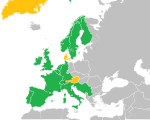The Royal Palace of Madrid (Spanish: Palacio Real de Madrid) is the official residence of the Spanish royal family at the city of Madrid, although now used only for state ceremonies.
The palace has 135,000 m2 (1,450,000 sq ft) of floor space and contains 3,418 rooms. It is the largest functioning royal palace and the largest by floor area in Europe.The palace is now open to the public, except during state functions, although it is so large that only a selection of rooms are on the visitor route at any one time, the route being changed every few months. An admission fee of €13 is charged; however, at some times it is free. The palace is owned by the Spanish state and administered by the Patrimonio Nacional, a public agency of the Ministry of the Presidency. The palace is on Calle de Bailén ("Bailén Street") in the western part of downtown Madrid, east of the Manzanares River, and is accessible from the Ópera metro station. Felipe VI and the royal family do not reside in the palace, choosing instead the Palace of Zarzuela in El Pardo.
The palace is on the site of a bygone Muslim-era fortress constructed by Emir Muhammad I of Córdoba in the 9th century. The imposing Alcázar of Madrid provided both a safe for the royal treasure and a habitual residence to the Trastámara monarchs in the late middle ages. Having endured substantial expansion works during the 16th century, the royal alcázar remained on the site until it burned down on 24 December 1734. A new palace was thereafter built from scratch on the same site on behalf of the Bourbon dynasty. Construction spanned the years 1738 to 1755 and followed a Berniniesque design by Filippo Juvarra and Giovanni Battista Sacchetti in cooperation with Ventura Rodríguez, Francesco Sabatini, and Martín Sarmiento. During the Second Spanish Republic the building was known as "Palacio Nacional".
The interior of the palace is notable for its wealth of art and the use of many types of fine materials in the construction and the decoration of its rooms. It includes paintings by artists such as Caravaggio, Juan de Flandes, Francisco de Goya, and Velázquez, and frescoes by Giovanni Battista Tiepolo, Corrado Giaquinto, and Anton Raphael Mengs. Other collections of great historical and artistic importance preserved in the building include the Royal Armoury of Madrid, porcelain, watches, furniture, silverware, and the world's only complete Stradivarius string quintet.










